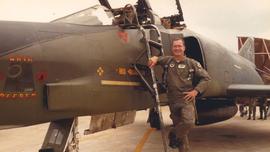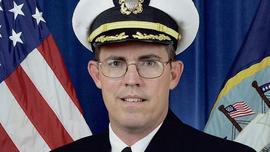I'd like to recognize a wonderful RF-4C 69-381. A great jet that took a missile 30 years ago today and although dying, held together long enuf for SPLASH and I to get out. Sleep well 381. You were a great jet!
Thx to the SAR folks from the USS SARATOGA for dipping us out of the drink! They deserved our Name Tags, etc. SQUID
Is that you Mike Ross? I flew 381 ten years before Timmy shot you down.
https://www.cbsnews.com/news/friendly-fire-victim-outraged-over-navy-officers-admiral-promotion/
Friendly-fire victim outraged over Navy officer's admiral promotion
- (CBS News) A U.S. Navy officer named Timothy Dorsey is up for promotion to admiral.
Whether he gets it may be determined by something he did a quarter century ago as an airman -- something so bizarre, even he can't fully explain it. But, it changed forever the life of a fellow airman, Mike Ross.
This photograph shows Mike Ross when he was a young Air Force pilot.
CBS NEWS
Ross was a young Air Force pilot flying reconnaissance missions in an F-4 Phantom jet. Grainy video taken by a Navy F-14 shows his plane during an exercise 25 years ago over the Mediterranean.
After taking a closer look, the F-14 pilot did the unimaginable. He shot Ross down.
"It took the tail off the airplane," Ross said.
He ejected at 630 miles per hour causing leg, shoulder and spine injuries, which have degenerated over the years requiring 32 surgeries. Ross said it "ruined his life," and he is still in physical pain.
"It basically made me 100 percent disabled by Air Force standards," Ross said.
Navy officer Lt. Junior Grade Timothy Dorsey
CBS NEWS
Insult was added to injury last year when the Navy nominated the pilot who shot him down -- then Lt. Junior Grade Dorsey -- for promotion to admiral.
Ross said his reaction was "almost visceral."
"I almost got sick," he said.
Ross claimed he had been under the impression that Dorsey had been let go.
An investigation determined Dorsey had received an order -- "red and free" -- which according to his sworn statement he thought "would never be used unless it was a no-kidder, a real-world threat situation." He interpreted "red and free" as permission to open fire, an inexplicable decision since everyone else in the exercise understood it to mean a simulated shoot down. Dorsey himself admitted "it was a bad decision."
He was never allowed to fly again, so he became an intelligence officer. The Navy kept promoting him despite the black mark on his record.
Dorsey declined to be interviewed, but Navy officials say he was selected for admiral because his performance as an intelligence officer made up for that one terrible mistake early in his career.
After the promotion became public, Ross received a letter from Dorsey saying, "I was unaware you suffered from any lingering injuries.... I am truly sorry for the incident and even sorrier for its impact on you."
Ross believes he got the letter 25 years after the incident because Dorsey was nominated for admiral.
Ross complained to members of Congress, who have the power to block Dorsey's promotion. He said he forgives him, however.
"I forgive him because if I don't forgive him I'll carry him with me for the rest of my life, and he's not worth that," he said.
Two pilots whose flight paths crossed so disastrously 25 years ago -- only this time it's Ross trying to shoot Dorsey down.
© 2013 CBS Interactive Inc. All Rights Reserved.



